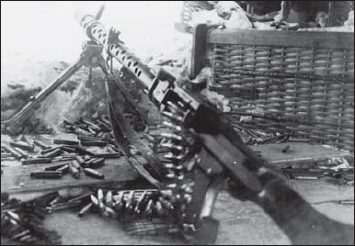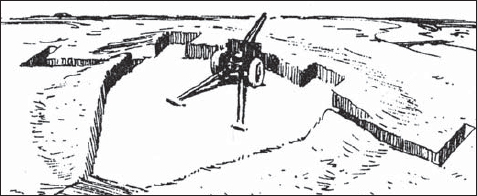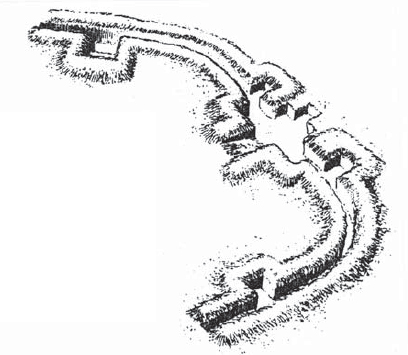Defensive firepower
The infantry regiment
The German infantry regiment was a well-structured unit with a complete range of support weapons allocated to all subunits. The types of automatic weapons, mortars and infantry guns were well balanced. The main flaw was inadequate anti-armour weapons, but attempts were made to improve them through the war. With one minor exception, the subunits at all levels were organised in triangular form and most support weapons were allocated so as to provide one weapon or a pair of weapons to each subordinate unit.
Divisional artillery ranges
A division artillery regiment had three battalions (Artillerie-Abteilung) each with twelve 10.5cm howitzers (pictured below), the standard divisional light artillery piece. (There was no 8.8cm artillery piece, despite this being often stated: 8.8cm flak guns were used for anti-armour fire, but not in the indirect fire role.) The 7.5cm gun, which had been replaced by the 10.5cm prior to the war, was reissued late in the war and was a poor substitute for the 10.5cm. The regiment also had a battalion with twelve 15cm howitzers and four 10cm (actually 105mm) guns for long-range counter-battery fire.
| Artillery |
Range |
| 7.5cm le.F.K.18, light field gun |
9,425m |
| 10.5cm le.F.H.18, light field howitzer |
10,675m |
| 15cm s.F.H.18, heavy field howitzer |
13,325m |
| 10cm s.K.18, heavy gun |
19,015m |
While the German Army was oriented towards mobile, offensive warfare, the infantry regiments, comprising the bulk of the combat power, still went largely by foot, with only small numbers of trucks and numerous horse-drawn wagons and carts to haul supplies and equipment.
There were numerous types of infantry regiments including mountain, light infantry, motorised infantry, and occupation or static troops. They were based on the same structure as the following standard 1939 infantry regiment, the basic common organisation. There were exceptions, depending on when the regiment was raised, including minor changes in weapons allocation, substitution of certain weapons by others, and slight differences of subunit organisation. The later two-battalion regiments mirrored this basic structure. Strengths are approximate, since units were habitually undermanned, thus rendering the authorised strength virtually meaningless.
The 3,250-man infantry regiment consisted of a staff section with mounted (on horseback, but soon replaced by bicycles), pioneer and signal platoons (Zug); a light infantry column (leichte Infanterie Kolonne – supplies, ammunition, baggage transport); I–III infantry battalions (Bataillon); and infantry gun and armour defence companies (Kompanie).
The 850-man battalions possessed a staff section with signal platoon and trains (Troß), three rifle companies and a machine-gun company. The companies were numbered in sequence through the regiment: I, 1st–4th companies; II, 5th–8th; and III, 9th–12th. The 4th, 8th, and 12th companies were machine-gun armed. The machine-gun company (Machinegewehr-Kompanie) had a company troop (Kompanie-Trupp – company headquarters), three heavy machine-gun platoons and a heavy-mortar platoon. The machine-gun platoons had three squads, each of two troops, with each manning a 7.92mm MG.38 tripod-mounted machine gun for a total of 12 guns. The mortar platoon had three squads, each with two troops, for a total of six 8cm s.Gr.W.34. (English-language publications refer to machine-gun and mortar squads – Gruppe – and troops – Trupp – as sections and squads, respectively, as they would be termed in a US organisation.)
The 190-man rifle (Schützen) companies had a company troop and trains (combat, rations, baggage), three rifle platoons, plus an anti-armour rifle squad. The 48-man rifle platoons had a platoon leader, an NCO troop leader (equivalent to a platoon sergeant), two messengers and a medical orderly in the platoon troop (Zug-Trupp). The platoon had a three-man light mortar troop with a 5cm le.Gr.W.36 mortar intended to engage machine-gun nests and small groups of infantrymen. There were initially four 10-man squads with a squad leader, troop leader (assistant squad leader), machine gunner, his assistant, an ammunition man, and five riflemen. The three-man MG.34 light machine-gun troop operated under the squad leader’s control. The riflemen operated as the rifle troop under the direct control of the troop leader. The squad leader had a 9mm MP.38 or MP.40 machine pistol, the machine gunner a 9mm P.08 Luger or P.38 Walther pistol, while all the others had 7.92mm Kar.98k Mauser carbines. One rifleman had a rifle grenade launcher, and two hand grenades were carried by most men.

An MG.34 machine gun in the embrasure of an Eastern Front bunker. The firing port is made from boards and snow-filled wicker ammunition containers.
Machine guns
A brief discussion of light and heavy machine guns is in order. The MG.34 and later MG.42 machine guns served in many roles. In German practice, the terms ‘light’ and ‘heavy’ defined the machine gun’s role, not its weight. In the light machine-gun role the weapon was used on its bipod or fired from the hip or shoulder. It provided half the rifle squad’s firepower and the squad’s manoeuvre tactics and defence were centred on the gun. The three-man troop carried one spare barrel. In the heavy machine-gun role the weapon was manned by a six-man troop, mounted on a tripod, provided with a long-range optical sight, and had three spare barrels to provide supporting long-range overhead and flanking fire.
The company’s seven-man anti-armour rifle squad had three 7.92mm Pz.B.39 Panzerbüchse anti-armour rifles. By 1941 this weapon was obsolete, but remained in limited use for a time. It used a 7.92 x 94mm cartridge, much larger than the 7.92 x 57mm used in carbines and machine guns (the second number indicates the case length). Other models were used, including captured weapons.
Infantry artillery
The 13th Infantry Gun (Infanteriegeschütz) Company possessed a headquarters, signal section, two light-gun platoons and a heavy-gun platoon. Its armament comprised four 7.5cm le.IG.18 light infantry guns and two 15cm s.I.G33 heavy infantry guns, two per platoon. These were short-range howitzers manned by infantrymen, and could provide immediate indirect and low-angle fire for the regiment without having to rely on divisional artillery, thus ensuring any attack’s momentum was maintained. The 14th Armour Defence (Panzerabwehr) Company, Anti-armour (Panzerjäger) from April 1940, had four platoons, each with four 3.7cm Pak.35/36 anti-armour guns and a light machine gun troop. These companies remained designated 13th and 14th even in two-battalion regiments. The tactical allocation of these weapons in the defence has already been discussed in the Planning the defences chapter.

Machine-gun bunkers were built in many forms. This version provided a relatively small position for a light machine gun. It had minimal space for the two-man crew, protected from light-mortar and small-arms fire, and was difficult to detect if properly camouflaged.
As new divisions were raised during the first three years of the war, there were many variations in regimental subunit organisation and weapon allocation. Rifle platoons were fielded with three rather than four squads, but the company received a heavy machine-gun squad with two MG.34s. This soon disappeared and all platoons had three squads. Many units were raised without the 5cm mortar in each rifle platoon or the three company anti-armour rifles. Other battalions lacked the machine-gun company’s 8cm mortar platoon. Some regiments were fielded with a 15th Pioneer Company, but they were soon withdrawn and organised into pioneer battalions.
Three Fallschirmjägern fire an 8cm Gr.W.34 mortar from a standard mortar firing position.
Anti-armour gun positions could be circular, oval or hastily prepared as here. Ammunition niches have been dug to the rear, as have armour protection trenches. A slit trench has also been dug beneath the gun.
From 1940 regiments were being raised with the infantry gun company having only four 7.5cm guns. Other regiments had no regimental companies or battalion machine-gun companies, merely a heavy company (schweren-Kompanie) in each battalion with four light infantry guns and four 3.7cm anti-armour guns. In 1942 on the Eastern Front the 13th Infantry Gun Company began to be replaced by a mortar company with eight captured Soviet 12cm HM38 mortars: the Germans soon began manufacturing a direct copy, the 12cm Gr.W.42. The 13th Mortar (Grantwerfer) Company became a fixture in most regiments. The 3.7cm Torklopfer (‘door-knocker’) anti-armour guns began to be replaced by 5cm Pak.38 guns in 1940/41. While the 7.5cm Pak.40 was intended for divisional and corps/army-level anti-armour battalions, some found their way to infantry regiments. The 5cm mortars were withdrawn from use in late-1943 for being impotent. They were replaced by short-barrelled 8cm Gr.W.42, which may or may not have been received. In late-1942, the one-shot, disposable, anti-armour Panzerfaust (‘Armour-fist’) rocket launcher began to appear and by the end of the following year was in wide use. They were issued to riflemen as needed and did not require crew.
Late-war restructuring
The new-type 1944 infantry division saw the loss of a battalion from each regiment – a 45 per cent strength reduction, to 1,987 men per regiment. The 184-man regimental staff included signal, pioneer (six le.MG.) and cyclist (three le.MG.) platoons plus small trains. The 708-man battalions each had three 142-man rifle companies, a 205-man machine-gun company, and 65 men in the staff section and trains. The rifle companies had 16 light machine guns and two 8cm mortars. The machine-gun companies had three platoons each with four heavy machine guns or two four-gun platoons and a platoon with two 2cm Flak.38 automatic guns, plus a platoon with four 12cm mortars. The 13th Infantry Gun Company had six 7.5cm and two 15cm infantry guns, although these were in short supply. The 14th Anti-armour Company had three platoons of four heavy anti-armour guns, which could have been the 7.5cm Pak.40, 7.5cm Pak.97/38 (French 75mm barrels on Pak.38 carriages) or 7.62cm Pak.36(r) (captured Soviet M1936 field guns modified for the anti-armour role), the latter being in extremely wide use. In reality they usually had fewer guns and some may have been substituted by 5cm guns.

7.5cm and 15cm infantry gun positions comprised a circular pit with armour protection trenches on two sides. This one has a low berm behind the exit ramp and ammunition niches are located to either side and to the rear.
A partially completed position for a 7.5cm Pak.40 anti-armour gun. Constructed in an open field, its low profile would reduce the gun’s outline, although this did limit the field of fire.
The People’s Grenadier (Volks-Grenadier) divisions fielded in late-1944 also had only two battalions per regiment. The grenadier companies had only two ‘machine-pistol’ platoons, each with four light machine guns and no other crew-served weapons. In theory the platoons were supposed to be armed with 7.92mm MP.43/Stg.44 assault rifles. (Originally the MP.43 was designated a machine pistol, but in 1944 it was redesignated an assault rifle to better describe its role and prevent confusion when requesting ammu nition – other machine pistols were 9mm. The MP.43/Stg.44 used a 7.92 × 33mm round, shorter than that used in carbines and machine guns.) Platoons of this period often still had Kar.98k carbines, sometimes with a single semi-automatic 7.92mm G.43 rifle per squad. The battalion heavy companies (4th and 8th) had two four-gun heavy machine-gun platoons and a platoon of six 8cm mortars. The 13th Infantry Gun Company had four light infantry guns in two platoons, two of which may have been substituted by heavy guns, plus two mortar platoons with four 12cm mortars each. The 14th Armour Destroyer (Panzerzerstörer) Company had up to 54 shoulder-fired 8.8cm R.PzB.43 or 54 Panzerschreck (‘Armour-terror’) rocket launchers, an enlarged version of the US bazooka. It had three platoons with 18 launchers in three squads. Some companies had a platoon with three 7.5cm anti-armour guns.

An artillery position might be dug in this triangular style, but circular, oval, and square pits were used as well. A dug-in artillery position was comparatively large to allow the 8–10-man crew to function. Ammunition niches are dug into the position’s front and others would be located to the rear. A ramp to the rear allows the gun to be removed.
A firing position for the 15cm rocket projector (Feuerstellung für 15cm Nebelwerfer) required substantial protection for the crew and ammunition from the launcher’s considerable back-blast. The launcher would be in the central position, and there are ammunition niches on either side. The crew shelters are in the curved trench wings.
The 1945 infantry division’s regiments were similarly organised, but the battalion heavy companies (4th, 8th, 12th) had only two light infantry guns and eight 8cm mortars (no machine guns) while the regimental 13th Heavy Company had a platoon with two heavy infantry guns and eight 12cm mortars in two platoons. The 14th Company now had 18 spare Panzerschreck rocket-launchers
There were numerous corps- and army-level units that could be deployed in immediate support behind or with the frontline infantry to thicken the line. These included machine-gun (48 heavy), heavy mortar (36 × 12cm), anti-armour (36 × 7.5cm), light air defence (36 single and 9 quad 2cm, 12 × 3.7cm), heavy air defence (24 × 8.8cm), assault-gun (18 guns) and pioneer battalions. Late in the war, machine-gun battalions were often employed in the frontline in lieu of infantry units. This provided significant automatic-weapon fire and allowed in-depth positioning, but these units had limited counter-attack ability and possessed few anti-armour guns and mortars.








